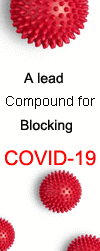| Description: |
Palmatine shows significant antidepressant-like, anti-hyperlipidemia, hepatoprotective, and antioxidant effects, it inhibited MAO-A, I(K) and I(CRAC) activity, and activated the AhR-CYP1A pathway. Palmatine shows the strong toxic action on T. thermophila BF5 growth, it is toxic to insects and vertebrates and inhibited the multiplication of bacteria, fungi and viruses, it is active at the alpha 2-receptor ( IC50 of 956 nM). |
| Targets: |
P450 (e.g. CYP17) | MAO | NF-kB | LDL | DNA/RNA Synthesis | 5-HT Receptor | Adrenergic Receptor | AChR | Antifection | alpha 2-receptor |
| In vitro: |
| Mol Carcinog. 2015 Oct;54(10):1227-34. | | Palmatine inhibits growth and invasion in prostate cancer cell: Potential role for rpS6/NFκB/FLIP.[Pubmed: 25043857] | Novel agents are desperately needed for improving the quality of life and 5-year survival to more than 30% for metastatic castrate-resistant prostate cancer. Previously we showed that Nexrutine, Phellodendron amurense bark extract, inhibits prostate tumor growth in vitro and in vivo. Subsequently using biochemical fractionation we identified butanol fraction contributes to the observed biological activities.
METHODS AND RESULTS:
We report here that palmatine, which is present in the butanol fraction, selectively inhibits growth of prostate cancer cells without significant effect on non-tumorigenic prostate epithelial cells. By screening receptor tyrosine kinases in a protein kinase array, we identified ribosomal protein S6, a downstream target of p70S6K and the Akt/mTOR signaling cascade as a potential target. We further show that palmatine treatment is associated with decreased activation of NFκB and its downstream target gene FLIP. These events led to inhibition of invasion. Similar results were obtained using parent extract Nexrutine (Nx) suggesting that palmatine either in the purified form or as one of the components in Nx is a potent cytotoxic agent with tumor invasion inhibitory properties. Synergistic inhibition of rpS6/NFκB/FLIP axis with palmatine may have therapeutic potential for the treatment of prostate cancer and possibly other malignancies with their constitutive activation.
METHODS AND RESULTS:
These data support a biological link between rpS6/NFκB/FLIP in mediating palmatine-induced inhibitory effects and warrants additional preclinical studies to test its therapeutic efficacy. | | World J Gastroenterol. 2003 Feb;9(2):329-33. | | Effects of palmatine on potassium and calcium currents in isolated rat hepatocytes.[Pubmed: 12532460] | To study the effects of palmatine, a known inhibitor on delayed rectifier potassium current and L-type calcium current (I(Ca,L)) in guinea pig ventricular myocytes, on the potassium and calcium currents in isolated rat hepatocytes.
METHODS AND RESULTS:
Tight-seal whole-cell patch-clamp techniques were performed to investigate the effects of palmatine on the delayed outward potassium currents (I(K)), inward rectifier potassium current (I(K1)) and Ca(2+) release-activated Ca(2+) current (I(CRAC)) in enzymatically isolated rat hepatocytes.
Palmatine 0.3-100 microM reduced I(K) in a concentration-dependent manner with EC(50) of 41.62+/-10.11 microM and n(H), 0.48+/-0.07 (n=8). The effect of the drug was poorly reversible after washout. When the bath solution was changed to tetraethylammonium (TEA) 8 mM, IK was inhibited. Palmatine 10 microM and 100 microM shifted the I-V curves of I(K) downward, and the block of I(K) was voltage-independent. Palmatine 0.3-100 microM also inhibited I(CRAC) in a concentration-dependent manner. The fitting parameters were as follows: EC(50)=51.19+/-15.18 microM, and n(H)=0.46+/-0.07 (n=8). The peak value of I(CRAC) in the I-V relationship was decreased by palmatine 10 microM and 100 microM. But the reverse potential of I(CRAC) occurred at Voltage=0 mV in all cells. Palmatine 0.3-100 microM failed to have any significant effect on either inward or outward components of I(K1) at any membrane potential examined.
CONCLUSIONS:
The inhibitory effects on I(K) and I(CRAC) could be one of the mechanisms that palmatine exerts protective effect on hepatocytes. |
|
| In vivo: |
| J Hazard Mater. 2009 Sep 15;168(2-3):609-13. | | Action of palmatine on Tetrahymena thermophila BF5 growth investigated by microcalorimetry.[Pubmed: 19286310 ] |
METHODS AND RESULTS:
Using a thermal activity monitor (TAM) air isothermal microcalorimeter with ampoule mode, the thermo-genic curves of the metabolism of Tetrahymena thermophila BF(5) growth at 28 degrees C were obtained and the action of palmatine on it was investigated. Meanwhile, the biomass change during the process of T. thermophila BF(5) growth coexisted with palmatine was studied by a haemacytometer. The results showed that a low concentration (50 microg/mL) of palmatine began to inhibit the growth of T. thermophila BF(5), and when the concentration of palmatine reached 600 microg/mL, T. thermophila BF(5) could not grow at all. The relationship between the growth rate constant (k) and the concentration c was almost linear with the correlation coefficient of 0.9957, showing the strong toxic action of palmatine on T. thermophila BF(5) growth.
CONCLUSIONS:
The biomass during T. thermophila BF(5) growth decreased obviously by the addition of palmatine at different concentrations. The investigation of biomass agreed well with the results obtained by means of microcalorimetry. |
|

 Cell. 2018 Jan 11;172(1-2):249-261.e12. doi: 10.1016/j.cell.2017.12.019.IF=36.216(2019)
Cell. 2018 Jan 11;172(1-2):249-261.e12. doi: 10.1016/j.cell.2017.12.019.IF=36.216(2019) Cell Metab. 2020 Mar 3;31(3):534-548.e5. doi: 10.1016/j.cmet.2020.01.002.IF=22.415(2019)
Cell Metab. 2020 Mar 3;31(3):534-548.e5. doi: 10.1016/j.cmet.2020.01.002.IF=22.415(2019) Mol Cell. 2017 Nov 16;68(4):673-685.e6. doi: 10.1016/j.molcel.2017.10.022.IF=14.548(2019)
Mol Cell. 2017 Nov 16;68(4):673-685.e6. doi: 10.1016/j.molcel.2017.10.022.IF=14.548(2019)

